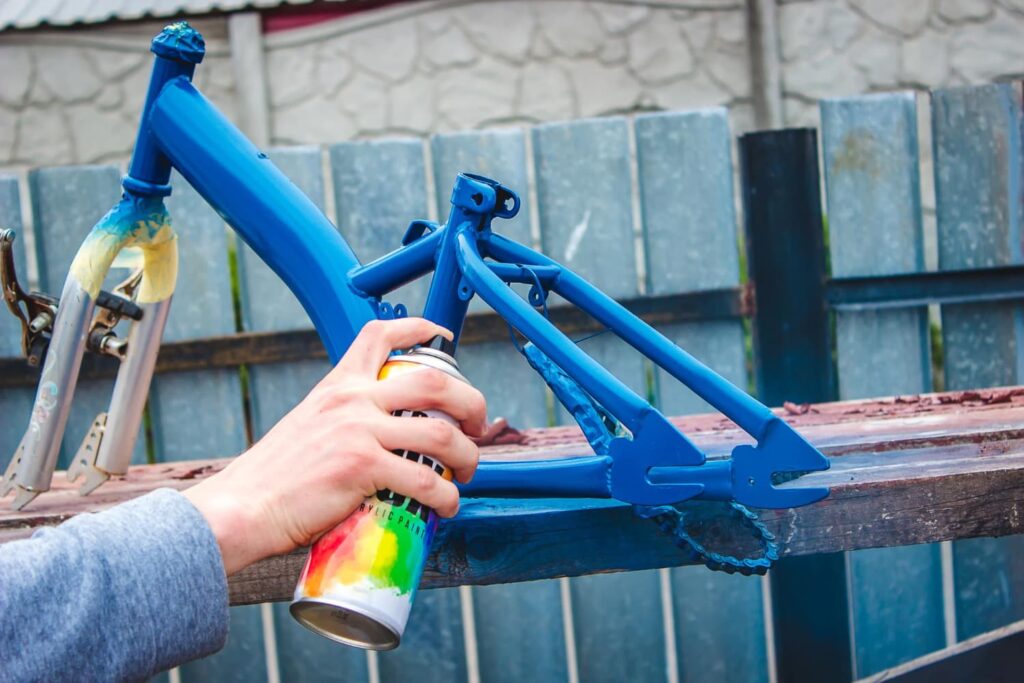Choosing the Right Tools and Materials
When it comes to painting your mountain bike frame, having the right tools and materials is crucial. The excitement of transforming your bike into a personal masterpiece can be dampened if you find yourself missing a key item halfway through the process. So, let’s get down to business.
Essential Tools
- Sandpaper: Various grits, from coarse to fine, will help you prepare the surface.
- Paint Stripper: If you’re repainting an old frame, this can help remove the previous coat.
- Masking Tape: Vital for protecting areas you don’t want painted.
- Paintbrushes and Roller: For applying your paint evenly, especially on intricate designs.
- Spray Paint or Bike Frame Paint: Choose high-quality paint suited for metal surfaces.
- Clear Coat: To protect your masterpiece from the elements after painting.
Materials You’ll Need
Your choice of paint can make a huge difference in the final look of your bike frame. Here are some materials you should consider:
- Acrylic Paint: Good for easy application and quick drying times.
- Enamel Paint: Tougher and more durable, making it a favorite for bike frames.
- Specialty Bike Paints: There are products out there specifically designed for bikes, which often provide superior adhesion and durability.
Now, if you happen to have a favorite color or design in mind, don’t be afraid to experiment! You can mix different shades or even use a stencil for that one-of-a-kind vibe.
Prepping Your Frame
Before diving into the actual painting, proper preparation is where the groundwork lays. Trust me, skipping this step will only lead to headaches later on.
Cleaning
Start by giving your bike frame a thorough wash. Use warm, soapy water to remove dirt, grease, and grime. Don’t skimp on this; a clean surface helps the paint adhere better.
Sanding
Next up is sanding. This is where your sandpaper comes into play. You want to create a rough surface so the paint has something to grip onto. Start with a coarser grit (around 80) and work your way to a finer grit (220). The end goal is a smooth finish. If you’re dealing with an old paint job, the paint stripper will come in handy here. Just follow the instructions carefully.
Masking
Use masking tape to cover any areas you do not want painted, such as the threads of the bottom bracket or cable guides. This is kind of like putting on a protective layer before the big event. You can also use newspapers or plastic to cover larger areas you want to protect.
Painting Techniques
Once your frame is prepped and ready, it’s time to unleash your artistic side. There are different methods to consider when it comes to applying paint to your bike frame.
Spray Painting
If you are using spray paint, hold the can about 12 inches from the surface and spray in thin, even layers. Start with the hard-to-reach spots and then work your way outwards. It’s all about building up layers rather than dumping paint all at once. If you overspray, it will run, and nobody wants that.
Brush Painting
For those who prefer a brush, apply paint in a systematic manner. Use long, even strokes, and don’t forget to paint the underside of the frame as well. It’s easy to forget, but it could lead to an unfinished look.
Creating a Design
If you want to get fancy, consider creating patterns or designs. You can use stencils or even painter’s tape to achieve lines or shapes. Dip a sponge in paint and dab it over a stencil for a sprayed effect, or get creative with splatter painting. Just remember to use a light touch—this should be fun, not a messy nightmare.
Drying and Curing
This is where patience really pays off. Once you’ve got your desired layers down, let it dry. The drying time can vary based on the type of paint and condition of the environment, but generally, 24 hours is a good rule of thumb. Give it a poke or a prod—if it feels tacky, it is not ready.
Curing Time
Okay, now let’s talk about curing. This step is often overlooked. Even if the paint feels dry, it might not be fully cured. Depending on the paint, curing can take anywhere from a few days to a couple of weeks. During this time, avoid exposing your bike to moisture or harsh conditions. It’s like letting a fine wine breathe—just give it time.
Applying a Clear Coat
After your paint has cured, it’s a great idea to apply a clear coat. This adds a shiny finish and protects your paint job from scratches, UV rays, and water damage. Think of it as a superhero cape for your bike’s new look.
Choosing the Right Clear Coat
You can find various clear coat options, including spray-on and paint-on types. Make sure to read the instructions and choose one that’s compatible with the type of paint you used. Apply it in thin, even layers similar to how you painted your bike frame.
Final Touches and Maintenance
Reassembling Your Bike
Once the clear coat is dry, it’s time to put everything back together. Make sure you are following the proper reassembly steps in that manual you probably have lying around. You do remember where you put those small parts, right? Organizing your workspace will save you from a minor freak-out moment.
Maintenance Tips
Now that you have your bike looking sharp and fresh, it’s vital to maintain it. Here are some simple tips to help you keep that paint job intact:
- Avoid rough surfaces: Try not to throw your bike against rough surfaces that could scratch the paint.
- Clean regularly: Use a gentle soap and warm water. Avoid harsh chemicals that may strip off the paint.
- Store properly: Keep your bike in a dry place, away from direct sunlight. Trust me, your paint will thank you.
Wrapping It Up
Painting your mountain bike frame is not just about aesthetics—it’s a fun project that allows you to express your personality and creativity. From selecting the right colors to applying the final clear coat, every step is an opportunity to enhance your bike’s look and show off some individuality.
With a bit of preparation, patience, and practice, you can turn an ordinary bike into a rolling work of art. So grab your tools, unleash your creativity, and enjoy the ride on your newly painted frame. Happy painting!






